Its been some months since I did my last post early in December 2015 and the next major one I'm planning on the Velocette VMT is taking some time to assemble, so I decided to do an interim post on the preparation of a new speedometer/tachometer dial face for a motorcycle...similar for a car....using the screen printing process.
But first....I'm happy to answer questions on dials and their printing, BUT I sold on this business to others....Howard Instruments in Melbourne, Victoria.....so can't supply any dials.
Lets look at some motorcycle dial faces that are common to be replaced with reprinted dials......
Chronometric motorcycle speedometer dial...the Smiths logo type indicates it was used in the period 1947-1958.
Four prewar dial faces...in this case illustrated from pre WW2 Vincent motorcycles, but used on other pre WW2 British motorcycles. The Smiths logo is the "shield" logo which was discontinued around 1946. For a concours motorcycle that is made prewar, its Smiths speedometer and tachometer must have this "Shield" logo to be correct.
Triumph Motorcycles use the Smiths "Revolator" dial face on their chronometric instruments from 1939 to about 1960 which had internal coloured bands for use as a tachometer as well as a speedometer. Illustrated are the 650cc type...note the 4th gear ring has a "70" = 7000rpm in the region of 116/118mph. The 500cc Triumph used another Revolator dial with the "70" around 109mph.
Smiths introduced new, replacement instruments for British motorcycles for the 1964 season. 80mm diameter they were not of the chronometric principle of operation that had been the norm from around 1927 to the end of 1963, but used the "eddy current" magnetic principle. Smiths called the speedometer the SSM...Speedometer Shallow Magnetic and the tachometer the RSM, Revcounter Shallow Magnetic.
Both the chronometric and the SSM used different dial blanks....
You can remove paint from existing dial faces and re-paint them with a form of matt or satin black as the background.
Or if you are into quantity as I was, you can have blanks lazer cut from 0.7mm steel.
So lets look at the screen printing of these dial faces.
I don't intend to go into the procedure for getting the images onto the screen for subsequent printing.
Lazer cut dial blanks prepared for grey faced SSM speedometers.....
An original, if a bit used, grey faced RSM dial from a Velocette Venom Thruxton.
A view of the printing screen with the image I'm to print...
The prepared dial blank and the "female" carrier used to locate the dial under the screen in the exact position to print the image.Note the small tabs on the dial face to locate the dial in the carrier.
Use an existing dial with the same image on it ( in this case a dry but slightly damaged image...ok for our purposes) and locate it under the screen so when the screen is closed the image is exactly in line, then tape the carrier in place. When printing multiple numbers of dials the locating tabs on the lazer cut dial blanks locate into the opposite in the carrier and ensure the printed image will always be in the correct position on the dial blank.
To avoid mess all over the screen mesh it is best to cut a paper blanking cover and tape it completely around its cut edge. Then only ink will pass on to the exposed area of the dial image.
Ensure the screen mesh surface is set about 2-3mm above the dial blank to be printed on...this is called the "snap" and ensures the screen will move up off the dial as the squeegee blade delivers the ink on to the dial blank.
Prepare ink onto the edge of the squeegee blade...I use white enamel screen printing ink which gives a deposit on the dial that your eye can detect in a 3 dimensional way, rather than the thin image from other forms of screen printing ink. The screen mesh I use is 140 mesh and of course the ink manufacturers claim enamel ink won't print through it..they say a max. of 90 mesh.
Funny that, I successfully printed tens of thousands of dials in the many years I was doing my printing...The fine mesh ensures fine text can be printed.
Pull a flood pass of ink across the screen image without actually having the squeegee blade touch the screen surface...this leaves a coating of about a mm of ink over the surface.
Then starting on one side of the dial image pull the squeegee blade on the mesh firmly and smoothly across the image, thus ensuring ink is forced through the image on the screen and onto the dial blank below.
Open the screen to removed the printed dial...I use a knife blade located into the odometer slot to pop the dial out of the carrier and down on to a dish for subsequent slow drying. Enamel ink takes several hours to dry the image. Despite this, speed is the essence or some residual ink left in the screen image will start to dry out...so either fit another dial blank into the carrier and repeat the process as many times as you require dial quantities or immediately clean the screen image with mineral turpentine, the solvent for enamel ink. I usually place paper towel under the image and use a turpentine wet paper towel to scrub carefully across the image above until there is no evidence of ink in the screen image.
Place the finished printed dials on their tray into a dust free area to dry for several hours.....
Then of course the dial can be fitted into a restored instrument to make the speedometer look brand new....
A completed instrument I did, including print the special dial face for a customer at the time who rode a HD and liked Ned Kelly the famous Australian bush ranger in the 1800s...
Of interest...how did Smiths print their dial faces?
They used an engraved image on a polished steel block and a gelatine block...the image on the steel block had ink to lightly coat into the engraved image and the gelatine block was pressed onto the image thus picking up the image onto the gelatin and pressed onto the dial blank.
Pictured below is the process scanned from a Smiths house magazine I have...the photo around 1934....
skip to main |
skip to sidebar
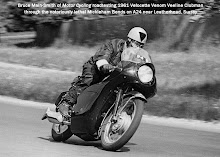
BMS in 1961 aboard a road test Velocette Venom Clubman Veeline

My co-rider, Dennis Fry, looking the consumate racer,probably the last to use a pudding basin helmet in competition...
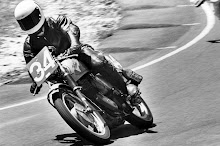
DQ aboard his VMT during the first 2 hour stint, pictured in Brabham loop

DQ reunited with VMT458 after 32 years
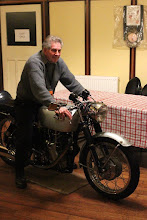
Dennis Fry re-united with VMT458, DQs co-rider in the 1971 Castrol 6 hour race
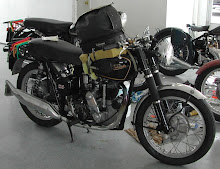
My 1962/1948 KSS/Scrambler Velo road bike, built in Canada in 1976 and imported into Sydney, Australia, May 2012 for use in local Australian Velo events......
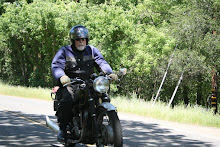
Riding in the Napa, Cal. area May 2010


North American Velo OC logo used for one of the Club's annual rally and rides

A site for Velocette material, other occasional motorcycle, banjo and jazz related stuff and motorcycle and automotive instrument information.
Acknowledgement of items used in this Blog from my archive...
I often feature items from older Motorcycle magazines, including photographs and other drawings, cartoons etc in my Blog. Where possible I acknowledge their source. These items are often from "MotorCycle" and "MotorCycling", and the current copyright holders are Mortons Motor Cycle Media. I thank them for their use.
Where other sources are used such as Fox Photos, Keystone Press and other now defunct press agencies from the
You are free to use any item from my Blog, but PLEASE give credit to the source.
Search This Blog
A photo I like....!

BMS in 1961 aboard a road test Velocette Venom Clubman Veeline
Stat. Counter- viewers to date
Need to contact me?
DQs Thruxton in the 1971 Castrol 6 hour Race, Amaroo Park,Sydney.

My co-rider, Dennis Fry, looking the consumate racer,probably the last to use a pudding basin helmet in competition...
DQs Thruxton in the 1971 Castrol 6 hour Race, Amaroo Park,Sydney.

DQ aboard his VMT during the first 2 hour stint, pictured in Brabham loop
VMT458 at the 2012 Australian Velocette Owners Club National Rally at Bundanoon, NSW.

DQ reunited with VMT458 after 32 years
VMT458 at the 2012 National Velocette Owners Club Rally at Bundanoon, NSW

Dennis Fry re-united with VMT458, DQs co-rider in the 1971 Castrol 6 hour race
Ready for another US Velo Ride

My 1962/1948 KSS/Scrambler Velo road bike, built in Canada in 1976 and imported into Sydney, Australia, May 2012 for use in local Australian Velo events......
DQ on his Velo Special

Riding in the Napa, Cal. area May 2010
DQ on his second KSS engined RS framed Velocette

Velo Thruxton at speed

North American Velo OC logo used for one of the Club's annual rally and rides
About Me
- The Velobanjogent
- I've motorcycled since the early 1960s...both in Australia, the USA,NZ and UK to where my long suffering wife and I rode a 1972 BMW R50/5 motorcycle via the overland route through Asia in 1974. Careers in Animal Physiology and Automotive Instruments and now finally semi retired into music...as a banjoist in Trad./Dixieland Jazz bands. Life for me is very interesting......
Other like minded sites to visit.....
- Club Ashfield...home of the Bridge City Jazz Band
- Gary McFetridge Banjo
- Greg Summerton's JAP site....
- John de Kruif's Vintage Norton Motorcycles
- John Jennings Oz Vintage Racer blog site
- John Stanley's motorcycles
- Jorge Pullin's "My Royal Enfields"
- Ken and Mollie Craven...well known for their Partitour years ago...
- Over the Rainbow and into a Book
- Paul d'Orleans Vintagent blog site
- Pete Young and Occhiolungo
- Sidecar Racing...it's never to late to have a happy childhood
- Silverdragons..some Motorcycle sport in the UK
- Speed Track Tales
- Sydney Banjo Club
- The Beezagent
- The Bridge City Jazz Band
- Worlds Fastest Velocette
Blog Archive
-
►
2021
(3)
- ► March 2021 (1)
- ► January 2021 (1)
-
►
2019
(1)
- ► December 2019 (1)
-
►
2018
(4)
- ► December 2018 (1)
- ► November 2018 (2)
- ► January 2018 (1)
-
►
2017
(5)
- ► December 2017 (1)
- ► August 2017 (1)
- ► April 2017 (1)
- ► January 2017 (1)
-
▼
2016
(6)
- ► December 2016 (1)
- ► November 2016 (1)
- ► April 2016 (1)
-
►
2015
(8)
- ► December 2015 (1)
- ► October 2015 (1)
- ► August 2015 (1)
- ► April 2015 (1)
- ► March 2015 (1)
- ► January 2015 (1)
-
►
2014
(13)
- ► December 2014 (2)
- ► November 2014 (1)
- ► September 2014 (2)
- ► April 2014 (1)
- ► March 2014 (1)
- ► February 2014 (1)
- ► January 2014 (1)
-
►
2013
(20)
- ► December 2013 (1)
- ► November 2013 (1)
- ► October 2013 (2)
- ► September 2013 (1)
- ► August 2013 (1)
- ► April 2013 (2)
- ► March 2013 (2)
- ► February 2013 (2)
- ► January 2013 (2)
-
►
2012
(37)
- ► December 2012 (3)
- ► November 2012 (2)
- ► October 2012 (2)
- ► September 2012 (3)
- ► August 2012 (3)
- ► April 2012 (4)
- ► March 2012 (3)
- ► February 2012 (4)
- ► January 2012 (3)
-
►
2011
(46)
- ► December 2011 (3)
- ► November 2011 (3)
- ► October 2011 (4)
- ► September 2011 (4)
- ► August 2011 (4)
- ► April 2011 (4)
- ► March 2011 (4)
- ► February 2011 (4)
- ► January 2011 (5)
-
►
2010
(63)
- ► December 2010 (3)
- ► November 2010 (5)
- ► October 2010 (4)
- ► September 2010 (7)
- ► August 2010 (6)
- ► April 2010 (6)
- ► March 2010 (6)
- ► February 2010 (4)
- ► January 2010 (5)
-
►
2009
(71)
- ► December 2009 (2)
- ► November 2009 (5)
- ► October 2009 (5)
- ► September 2009 (6)
- ► August 2009 (7)
- ► April 2009 (5)
- ► March 2009 (7)
- ► February 2009 (8)
- ► January 2009 (6)
-
►
2008
(111)
- ► December 2008 (7)
- ► November 2008 (13)
- ► October 2008 (8)
- ► September 2008 (10)
- ► August 2008 (14)
- ► April 2008 (12)
- ► March 2008 (4)
Subject listings in my blog
- "Best" oil pumps (1)
- "Motor Cycling in NSW" (1)
- "MotorCycling in Australia" V.1No.11 (1)
- "Motorcycling in NSW" (2)
- 149cc Velocette LE (2)
- 1914 Veloce; 1914 Veloce catalogue (1)
- 1930 motorcycle racing (1)
- 1938 ISDT (2)
- 1939; Omodei's accessories (1)
- 1971 Castrol 6 hour race (1)
- 1976 Castrol 6 Hour race (1)
- 2003 Cape to Cape Velocette Rally (1)
- 2005 Australian Centenary Velocette Rally (2)
- 2009 Australian Velocette Rally (2)
- 2010 Australian Velocette Rally (3)
- 2011 Australian Velocette Rally (1)
- 2012 Back to Bundanoon Australian Velocette Owners Club Rally (2)
- 2015 Aust. Velo OC Nat. Rally (1)
- 24 April 2011 (1)
- 74 and 75 IOM TT races (1)
- a visit to "Fellside Cottage2 (3)
- A.T. speedometers (1)
- A.T.instruments (1)
- A.T.tachometers (1)
- Adverts in Australian Motorcycle magazines (2)
- aka B.M.S (1)
- Allan Schafers correspondence and photos (9)
- Allen Burt photos (5)
- Alpha bearings-Velocette (1)
- Amal Carburettors (2)
- an obituary (1)
- Archival trip to UK 2016 (1)
- Ariel motorcycle info 1938 and 1939 (1)
- Army motorcycles (2)
- Artie Bell (1)
- Artur Fenzlau-photographer (5)
- AUCTION (1)
- Aviation (1)
- Banjos (2)
- Bathurst motorcycle races (1)
- bearing info etc (2)
- Benton & Stone Ltd (1)
- Bertie Goodman (3)
- BJG (1)
- blog problems (1)
- BMW (3)
- BMW R69S (1)
- BMW R90S racing (2)
- Bonhams auction (1)
- Bonneville Record Breaking (1)
- Book Review (30)
- Book Review- Circus Life by Don Cox (2)
- Book Review- Clymer's reprint of UK 'Motorcycling' WD service sheets (1)
- Book Review- Ferodo Record Braking 1938 (1)
- Broadford 2014 (1)
- Brooklands (1)
- Brooklands in 1974 (1)
- Brough Superior (1)
- Broughs at Auction (1)
- Bruce Main-Smith (1)
- BSA 1938 (1)
- Carl Drees (1)
- Cartoons (4)
- Castrol 6 hour (2)
- Castrol 6 Hour re-enactment (1)
- catalogue info (1)
- chain oilers (1)
- Chains (1)
- Christmas 2008 a photo montage.. (1)
- Christmas 2012 a photo montage.. (1)
- Circus Life by Don Cox (3)
- Continental Circus (1)
- crankcase relief valve (1)
- Craven luggage equipment (1)
- Dan Smith (1)
- death of a motorcycling friend (1)
- Dennis Fry (1)
- DKW Racing Motorcycles (1)
- DQ in UK Oct.2015 (1)
- DQ screen prints a dial;instrument dial faces (1)
- DQs bikes in 2015;Velocette; Velocette KSS specials (1)
- DQs early motorcycling (2)
- DQs early negatives (2)
- DQs miscellaneous small sized pic selection (1)
- DQs rider interviews- stars of the past (1)
- DQs UK trip 2017 (1)
- Drive gearboxes- tachometer type (1)
- dynamometers (1)
- dynamometers at Velocette (1)
- dynomometers (2)
- Earls Court Motorcycle Show (1)
- Early Australian motorcycling (4)
- early motorcycling photos (2)
- EARLY SPEEDWAY BIKES (1)
- engine testing (1)
- Enots (1)
- Eric Hinton (1)
- Ernie Lyons (1)
- Europe Velo Trip Sept.2013 (4)
- factors catalogue (1)
- Fagan Park (1)
- Family (1)
- Fisher photos (3)
- Fuel taps (1)
- G50 (1)
- Gary Ross (1)
- Gert Boll (1)
- go fast goodies (1)
- Happy New Year for 2010 (1)
- Harold Willis..Velocette engineer (2)
- Heinz Limbers (1)
- immed.post WW2; Omodei's accessories (1)
- IOM 1975 (2)
- Ivan Rhodes (4)
- Ivan Rhodes home (3)
- Jack Emmott (1)
- Jack Emmott Book of Engines AJS 7R G50 G45 (1)
- Jack Saunders (1)
- JAP (1)
- Jim Day (1)
- Jim Guthrie (1)
- Jones Motrola (2)
- Jones speedos & tachos (2)
- KDT Velocette (1)
- Keith Bryen racing photographs (17)
- Kesso's Velocette Auction (1)
- KSS Velocette (1)
- KTT Mk.6 Velocette (1)
- KTT Services. (2)
- KTT Velocette (6)
- Last for 2008 from The Velobanjogent (1)
- Les Slaughter photos (1)
- Lisbon 100 (1)
- Lockheed Super Constellation (1)
- M.I.R.A (1)
- Magazine review-Export Trader (1)
- Magnetos...Tim Thearle (1)
- Manx Norton (2)
- March 2013 (1)
- Matchless G50 (1)
- Maurie Pearsons photos (2)
- MECHANICAL STROBOSCOPE (1)
- Merry Christmas for 2017 (1)
- Mick Felder...; The passing of Mick Felder (2)
- Mick Felder's memorial service (1)
- miscellaneous racing photos (1)
- ML magnetos and the 1929 IOM TT (1)
- Model O (3)
- Mortons Media (2)
- Motometer (7)
- Motorcycle (13)
- Motorcycle advertising (1)
- Motorcycle and Car accessory shops (3)
- Motorcycle art (1)
- Motorcycle Auction (1)
- Motorcycle Engineering (3)
- Motorcycle instruments (2)
- Motorcycle pen and ink images (17)
- Motorcycle photograph (5)
- Motorcycle postage stamps (1)
- motorcycle racing in Europe in 1950's (1)
- Motorcycle Record Breaking (2)
- Motorcycle related (5)
- Motorcycle saddles (1)
- motorcycle scrapbooks (1)
- Motorcycle specials (2)
- Motorcycle Threads (1)
- Motorcycle...IOM TT (4)
- My business (1)
- No.5; (1)
- Northern Ireland road races 1946 (1)
- Norton (2)
- Norton pics.. (3)
- NSU (1)
- NSW Australia (1)
- NZ classic racing (1)
- Omodei data sheets (1)
- Omodei's accessories (1)
- Omodei's motorcycle accessories (3)
- Omodie's accessories (1)
- Omodie's motorcycle accessories (1)
- Phil Irving literature (6)
- photo report (1)
- photographs from my archive (10)
- photos by DQ (3)
- pics from DQs personal negatives (5)
- Pix from DQs 2017 UK trip (1)
- Prewar & just postwar pix (1)
- prewar motorcycle race circuits (1)
- Pukekohe 2006 (1)
- Pukekohe 2010 (1)
- Pukekohe 2011 (2)
- Pukekohe 2012 part 1 (1)
- Pukekohe 2012 part 2 (1)
- Race circuits-Blackheath (1)
- Racing circuits-Catalina Park (1)
- Racing in NSW 1955-60. (2)
- Racing Motorcycles (20)
- Rennsport BMW (1)
- Renolds (1)
- Rex McCandless (1)
- ROTOSCOPE (1)
- scanned (1)
- Smiths A.T. instruments (1)
- Smiths governor tachometers (1)
- Smiths instrument drives (2)
- Sorbo's BMW (1)
- Speedometer (12)
- Stafford Auction Oct.2015 (2)
- Stanley Woods (2)
- Steib sidecars (1)
- STROBORAMA (1)
- STROBOSCOPE (1)
- Stuart Hooper (1)
- tachometer (3)
- tachometers (4)
- tank filler caps (1)
- The Australian Motor Cyclist V.3 (1)
- The Castrol six hour race (3)
- The Continental Circus in the 1950s and 60s (1)
- tHE DEATH OF kEITH bRYEN (1)
- The Isle of Man Times...items from (2)
- The new Roarer (1)
- The Velocette factory from 1920's to Feb.1971 and liquidation.. (1)
- Travel (2)
- Ulster 100 (1)
- Unsuccessful 350 record attempt at Montlhéry 1963 (1)
- VDO motorcycle instrumets for BMW pre 1969 (1)
- Velo Show day (1)
- Velocette (6)
- Velocette 1921 Catalogue (1)
- Velocette 4 cylinder (1)
- Velocette archival items (1)
- Velocette chain information (1)
- Velocette Data sheets (6)
- Velocette engine (7)
- Velocette in Speedway (1)
- Velocette model O (3)
- Velocette motorcycle (9)
- Velocette MOV 250 (1)
- Velocette publicity photographs (4)
- Velocette racing motorcycle (7)
- Velocette racing photographs (12)
- Velocette rear suspension (1)
- Velocette research (2)
- Velocette VMT (3)
- Velocette- MOV/VMT (1)
- Velocette. MIRA (1)
- Velocettes at Broadford (1)
- Vic Willoughby (1)
- Vincent speedometer information (1)
- vision (1)
- Visiting Velo friends in The Netherlands and Germany (1)
- VMT458 (1)
- Vulcan 1000cc V twin Velocette (2)
- Waycott 600 Velocette (1)
- Webb girder forks (1)
- Whiffling Clara-KTT Velocette (1)
- Winston "Velocette" Churchill (1)
- Works Velocette (3)
- World motorcycle record breakers (3)
- Worlds Fastest Velocette (3)
- Worlds Fastest Velocette at Bonneville 2011 (1)


























